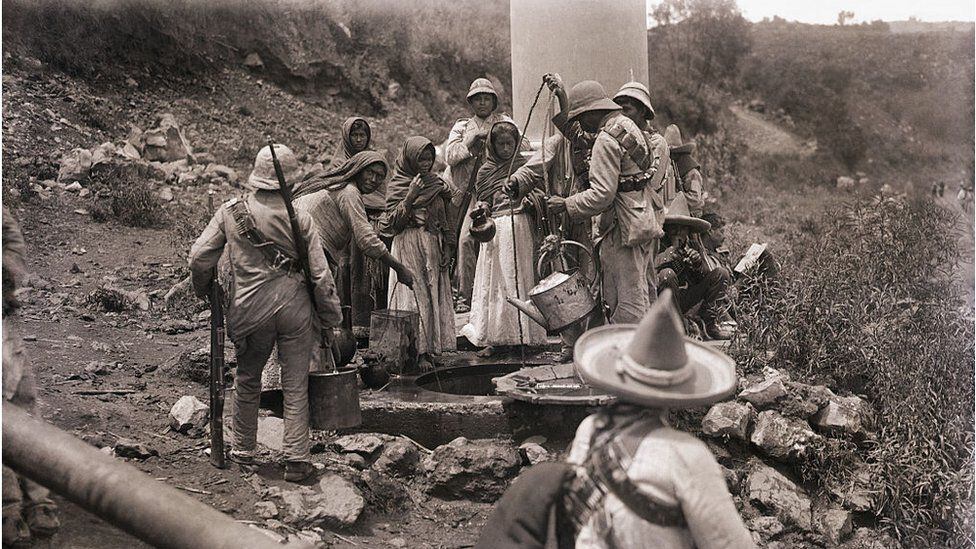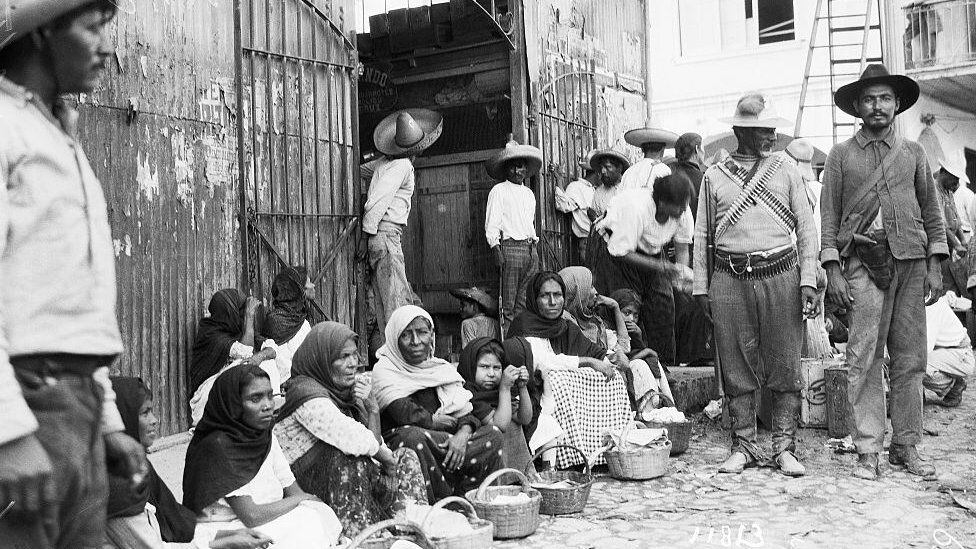Every revolution needs a hero and a muse.
Adela Velarde Pérez was both.
But, as with all identity myths, in the story of this woman who possibly inspired the most famous corrido of the mexican revolution and gave name to the “adelitas”, memory and legend are intertwined.
Look: Mexico: this is how the aircraft in which the police chief of Aguascalientes was traveling collapsed | VIDEO
The image of Adela Velarde, very young, with wide eyes, looking intensely at the camera from under her huge hat, holding a Mexican flag in one hand and a sword in the other, her tiny body crossed by a belt of bullets, embodies the essence of a national spiritof a brave and revolutionary Mexican identity.
She represents the thousands of anonymous women who joined the Mexican Revolution (1910-1920) known as “adelitas”, and who managed to overthrow the dictatorship of Porfirio Díaz.
The “La Adelita” corrido, perhaps the most famous of the entire period of the revolution, was sung obsessively on the front lines and is still heard today, popularized by singers like Jorge Negrete or Amparo Ochoa.
However, the story of the original “Adelita” remains in part a mystery.
What do we know about the real “Adelita”
It is known that he was born in the state of Chihuahua, probably in Ciudad Juárez, in the year 1900, into a wealthy family.
According to the biography that the Mexican government has about her, she was the granddaughter of the prominent Juarista general Rafael Velarde, who fought against French troops.
While still a teenager, he joined the ranks of the revolution, supporting the Mexican Association of White cross in nursing work.
It was part of the Northern Division of the Constitutionalist Army, and later joined the Northeastern Army Corps.
On February 22, 1941, Velarde was recognized as “Veteran of the Revolution” by the Mexican Secretary of National Defense and, according to the Museum of Women, was named a member of the Mexican Legion of Honor in 1962.
At the end of the revolution, she worked in Mexico City as a typist in the Post Office. in 1965 he met a colonel she had met in her years of struggle, Alfredo Villegas, whom she married in 1965.
Soon after, the couple moved to the United States, where they lived until her death in 1971 from ovarian cancer. His remains lie in the San Felipe Cemetery in Del Rio, Texas.

This is, practically, almost the only confirmed information that we have about it.
From there, almost everything is stories, more or less fabled, inspired by the romanticism of his character.
The myth portrays her as a brave and beautiful girl, whose revolutionary ideals made her an example for other women who joined the uprising, known today as “adelitas” and who played a fundamental role in the guerrillas.
The “adelitas”
Few have described the role of the “adelitas” in a more beautiful way than the writer Elena Poniatowska in his book “The Untamed”.
“I give you water. I take the pots and pans to make your food. I delouse you. I pack your petate. I wash your clothes. I gather the firewood to make a fire. I oil your rifle. I will I’ll light your cigarette, and if there’s no tobacco, I’ll make you one of macuche, here I have corn leaves. I load your Mauser and your cartridges. I take care that the gunpowder doesn’t get wet. I make you a home on the battlefield. I am your gut mattress. I have your son in the trench.”

Without them, affirms the Mexican author, there would have been no revolution. Many were taken by their men, husbands, fathers, or sons, into combat as support. Others were forcibly forced to participate and, although most performed basic and nursing support, some came to have important positions.
After having given blood, sweat and tears in battle, with the end of the war most of these women returned to the old roles that society provided for them, and their stories were forgotten.
Only a handful of names of “adelitas” have survived the anonymity of history, among them that of Adela Velarde, largely thanks to the corrido that bears her name.

The sweetest version of the history of this famous song, which became a symbol of the revolution and responsible for half the Spanish-speaking world not being able to hear the word “Adelita” without humming “he left with another…”, is narrated by Mexican historian José Alberto Galindo.
The legend
Galindo is the author of the book “A sky full of shrapnel: The true story of Adelita”, in which he tells the following story:
Velarde entered the revolutionary army as nursefor which she was disowned by her family, who considered, like others of her time, that women could only leave their family home to get married.
Shortly after joining the revolution, the young woman met Antonio Gil Del Río Armenta, a sergeant in Pancho Villa’s army, and the two had a close relationship. steamy romance.
According to some uncorroborated accounts, the two had a son, who would later die in World War II.
The love story also had a tragic end.

The sergeant was hit by a bullet in the city of Gómez Palacio, and died in the arms of his beloved. However, before passing away, he asked his love interest to look inside her duffel bag, where Velarde found a piece of paper with the lyrics of the song that would become a revolutionary national anthem. She had been his muse and would be his last love.
Too perfect? Well there’s more.
According to Galindo, the lyrics of the song were not complete, so Gil Del Río Armenta he sang to him right there, and with his last breath, the last stanzawhich Adelita noted on the paper in her own handwriting.
Some versions say that this last stanza dictated on the verge of death was the one that says: “If by chance I die in the campaign / and my corpse is going to be buried, / Adelita, for God’s sake, I beg you / that with your eyes you will cry for me“.
However, in an interview with the newspaper “Excélsior” in 1948, Velarde herself confirmed that it was she who inspired the composer, although the original corrido It only had three stanzas:
“Popular among the troops was Adelita, / the woman that the sergeant idolized, / because in addition to being brave she was pretty / that even the colonel himself respected her.
And if Adelita left with another/ I would follow her by land and by sea; / if by sea, in a warship / if by land, in a military train.
If Adelita wanted to be my wife, / if Adelita were my wife, / I would buy her silk dress / to take her to dance at the barracks“.

The historian Galindo also affirms that the “colonel” mentioned in the song is, to round things off even more, the man whom Adela Velarde finally married in 1965, Alfredo Villegas.
However, there are different versions about the origin of the song that, according to the Mexican Secretary of National Defense (SDN), was disseminated by the Northern Division between 1914 and 1915.
According to the book “The Armed Forces in the Mexican Revolution”, published by the SDN in 2013, some attribute its authorship to the young captain Elías Cortázar Ramírez, others to a certain Ángel Viderique.
Another interpretation states that it is an anonymous song that General Domingo Arrieta and his troops heard in the state of Sinaloa, and yet another that General Arrieta himself entrusted it to a teacher of his military band, Julián S. Reyes, to to write and orchestrate it.
But in the creation of myths, the story is important, and a good tragic love story will always be more powerful than a bland assignment.
Source: Elcomercio
I am Jack Morton and I work in 24 News Recorder. I mostly cover world news and I have also authored 24 news recorder. I find this work highly interesting and it allows me to keep up with current events happening around the world.

:quality(75)/cloudfront-us-east-1.images.arcpublishing.com/elcomercio/GE4TCNZNGEYS2MRQKQYDAORRHE.jpg)

:quality(75)/cloudfront-us-east-1.images.arcpublishing.com/elcomercio/GQZDCNJNGA2C2MJSKQ2TMORUGI.jpg)
:quality(75)/cloudfront-us-east-1.images.arcpublishing.com/elcomercio/WWQBJVUCIVALRFYLG3BIAVWQ6I.jpg)
:quality(75)/cloudfront-us-east-1.images.arcpublishing.com/elcomercio/6T5VR63ZIVHVHIZXGIZCSUVBCM.jpg)

